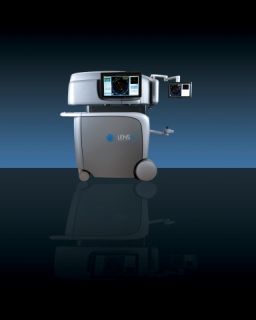Jun 11 2015
LENSAR, Inc., a global leader in next-generation femtosecond laser technology for refractive cataract surgery, today announced it has received the CE Mark from European Union regulators for a suite of five new application technologies integrated into the company’s flagship product, the LENSAR® Laser System.
 The LENSAR Laser System with Streamline is the first femtosecond laser cataract platform to enable automation of key surgical procedure planning and execution elements. (Photo: Business Wire)
The LENSAR Laser System with Streamline is the first femtosecond laser cataract platform to enable automation of key surgical procedure planning and execution elements. (Photo: Business Wire)
As the first femtosecond laser cataract platform to enable automation of key surgical procedure planning and execution elements, the LENSAR Laser System with Streamline™ application upgrades include:
- Wireless integration with popular topographers
- Iris registration
- Cataract density imaging
- Customized fragmentation patterns
- Arcuate incision planning
“This important approval, following so rapidly on the heels of our U.S. FDA clearance, is further evidence of LENSAR’s ongoing commitment to speeding innovation to the global market,” said LENSAR CEO Nicholas T. Curtis. “The Streamline upgrades to the LENSAR Laser System include innovative integration of functions to allow surgeons to fully automate and customize critical planning and execution steps of refractive cataract surgery for the first time.”
The European Union introduction of the LENSAR Laser System with Streamline will be held at the International Congress of German Ophthalmic Surgeons (DOC) at Congress Center Leipzig, June 11-13, Hall 2, Booth 39/40.
The LENSAR Laser System is the first femtosecond laser cataract platform to establish a wireless integration protocol with preoperative diagnostic devices. Enabling wireless data transfer of preoperative corneal measurements from the Cassini™ Corneal Shape Analyzer to the LENSAR Laser System improves procedure flow and eliminates potential errors from manual entry of data from the device used in the preoperative and surgical planning process. An exclusive feature of the integration with Cassini is the ability to wirelessly transfer the pre-operative un-dilated iris image from the Cassini to the LENSAR Laser for comparison to the iris image while the eye is fully docked under the LENSAR laser at procedure time and automatic compensation for cyclorotation by adjusting incision placement for improved refractive outcomes. This eliminates the need to manually ink mark the eye to identify and adjust for the cyclorotation that may occur when a patient is reclined during surgery. Lensar is working to integrate additional topographers, including the Aladdin Biometer.
“LENSAR’s integration of preoperative diagnostics represents significant innovation in the femtosecond cataract procedure that we anticipate will result in improved surgical efficiency and outcomes for patients,” said Professor Gerd Auffarth, Medical Director, University Eye Clinic Heidelberg. “The ability to automate aspects of the procedure addressing astigmatism, including iris registration, arcuate incision planning and steep axis corneal marking, is extremely valuable in delivering the refractive results patients expect from laser cataract surgery.”
Additionally, for the first time, surgeons have access to an arcuate incision planning table on the laser that includes parameters to define the location, depth and extent of the surgeon’s intended arcuate incisions based on individual patient biometric measurements and other factors defined by the surgeon. The arcuate incision planning capability allows surgeons to retain their plan preferences for later use, increasing surgical operating room efficiency. Exclusive to LENSAR and also included in the Streamline upgrade is a steep axis corneal marking function, providing non-refractive landmarks to support the surgeon’s management of astigmatism.
The Streamline upgrades also introduce integrated cataract density imaging, which automatically categorizes the cataract to a pre-programmed, surgeon-customized fragmentation pattern depending upon the density of the cataract and allows the surgeon to automatically isolate fragmentation to the nucleus. This first-in-market innovation may have a positive impact on efficiency and procedure time.
“Incorporating the surgeon preferences for fragmentation patterns and energy levels based upon automated cataract density analysis helps to ensure safe and efficient cataract removal,” said Dr. Detlef Holland, Medical Director, Nordblick Eye Clinic Bellevue. “While laser fragmentation is a hallmark of the femtosecond cataract procedure, the LENSAR Laser System’s unique preprogramming capabilities may directly benefit both patient comfort during the procedure and the visual outcomes achieved by the procedure.”
As the EU distributor for LENSAR, Topcon Europe Medical B.V. will manage in-market rollout of the LENSAR Laser System with Streamline. Streamline upgrades, including arcuate incision planning, steep axis corneal marking, cataract density imaging and customized fragmentation patterns, will be made available to all LENSAR users. Practices currently using the LENSAR Laser System and the Cassini Corneal Shape Analyzer, and eventually other topographers, will have access to the full Streamline technology suite including wireless integration and iris registration.
LENSAR has placed more than 140 systems with customers around the world since its introduction in July of 2012, and the system has been used in nearly 60,000 cataract surgery procedures.